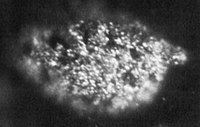
Photo from wikipedia
The release of residual ammonium (RA) leaching agent from weathered crust elution-deposited rare earth tailings would cause serious environmental pollution, and it was necessary to efficiently remove it from the… Click to show full abstract
The release of residual ammonium (RA) leaching agent from weathered crust elution-deposited rare earth tailings would cause serious environmental pollution, and it was necessary to efficiently remove it from the ore body before the mine closure. In this study, occurrence states of the RA were determined and dynamic elution of RA from rare earth tailings by using magnesium chloride as eluent was investigated. Effects of initial concentration, pH, flow rate, and particle size on the ammonium removal efficiency were investigated, and variations of ammonium occurrence states before and after elution were determined. Lastly, elution mechanism was discussed. Results showed that removal efficiency of RA by magnesium chloride was significantly higher than that by deionized water, and elution efficiency of RA could reach about 95.7% at the optimum laboratory experiment conditions. Energy dispersive spectrometer (EDS) analysis illustrated that the residual ammonium was replaced by Mg2+ during the elution process, and occurrence state experimental results showed that 94.0% of water-soluble and adsorbable ammonium was eluted. The empirical kinetic equation of eluting RA by magnesium chloride was established as 1-2/3α-(1-α)2/3= 0.02*C00.6t. This study provided a valuable method for reducing environmental pollution caused by the release of the residual ammonium from the rare earth tailings.
Journal Title: Environmental research
Year Published: 2022
Link to full text (if available)
Share on Social Media: Sign Up to like & get
recommendations!